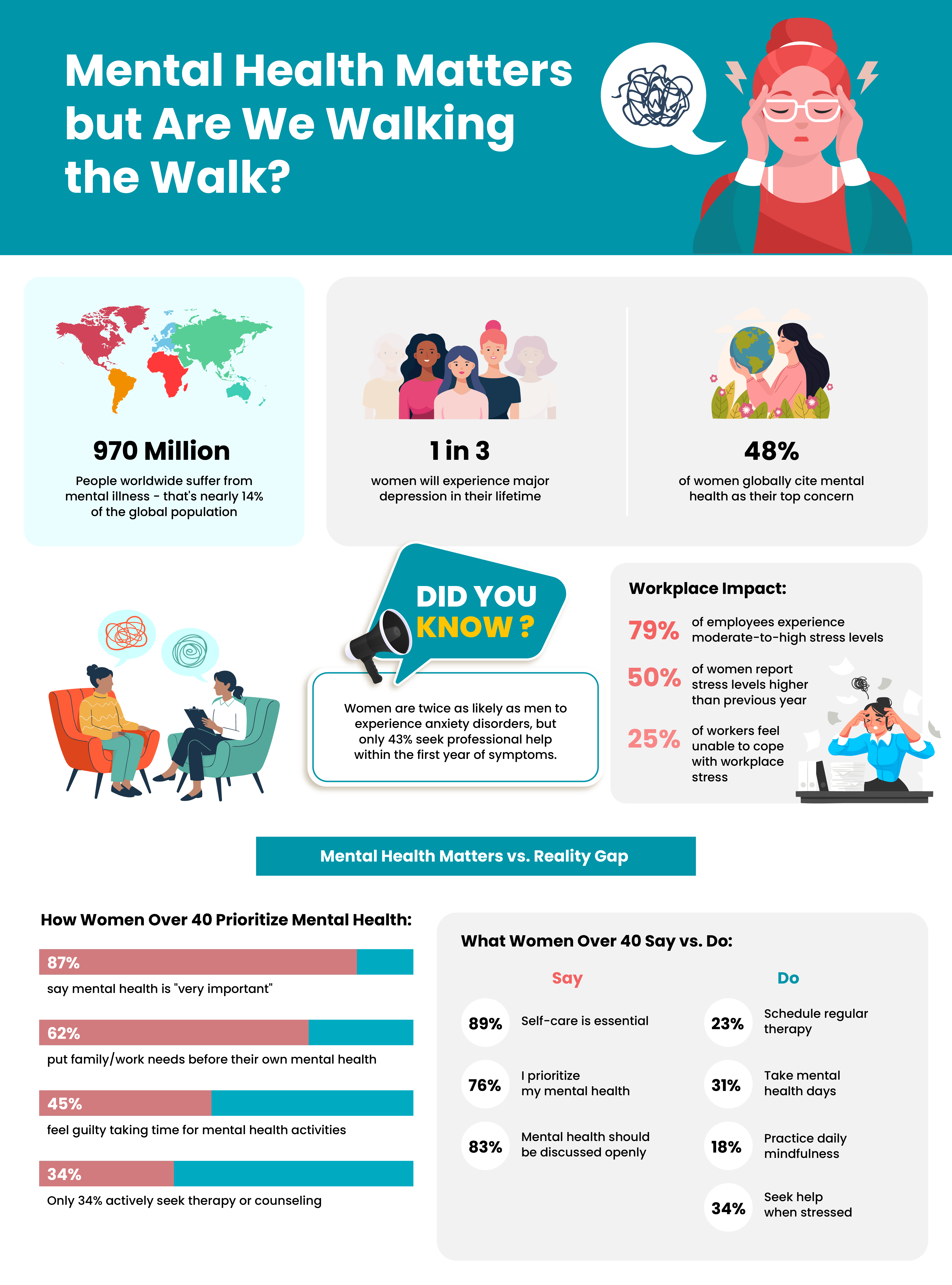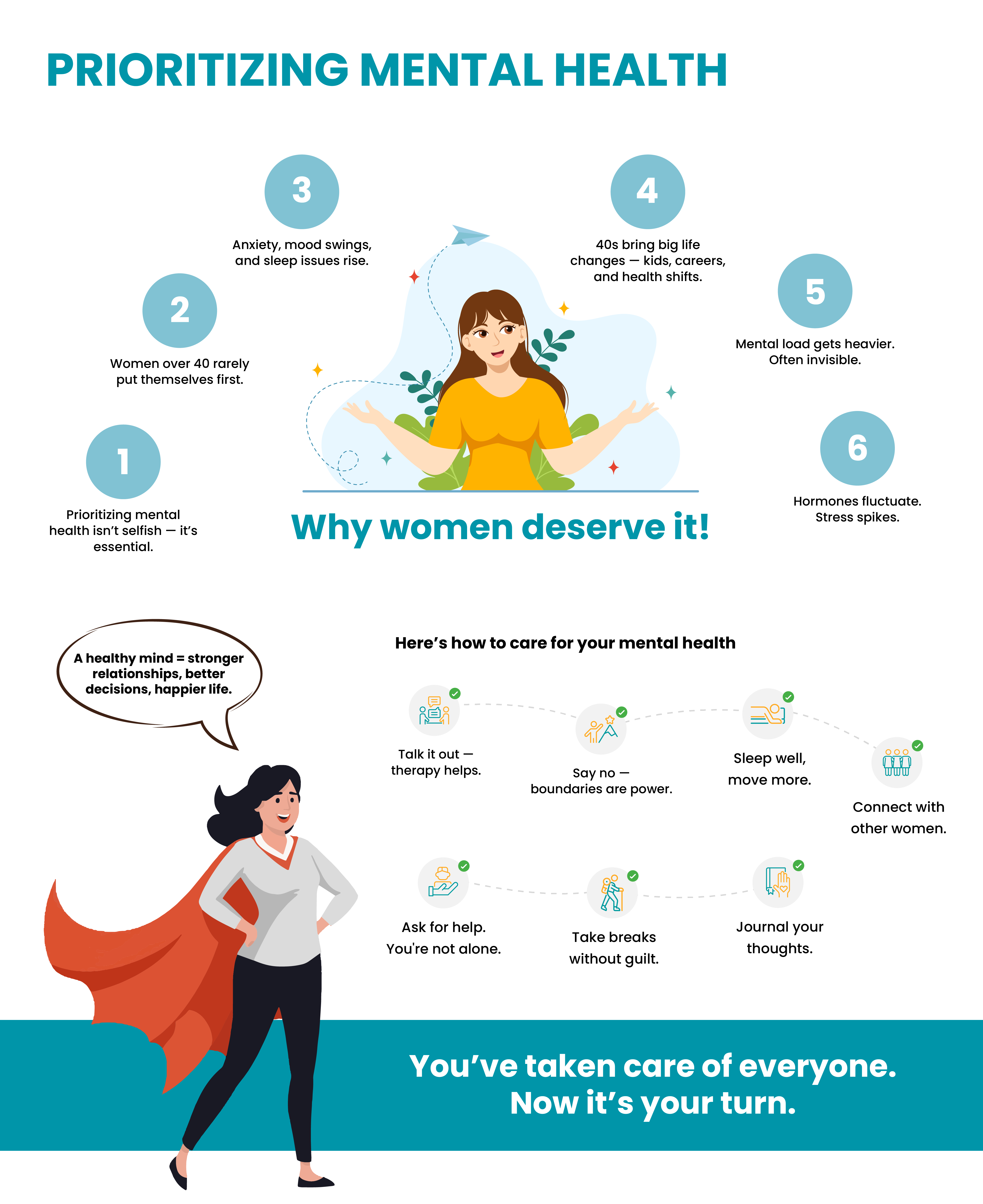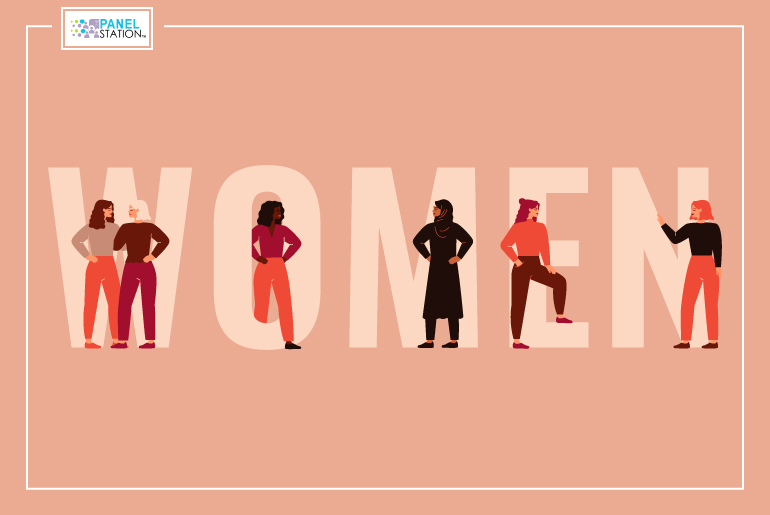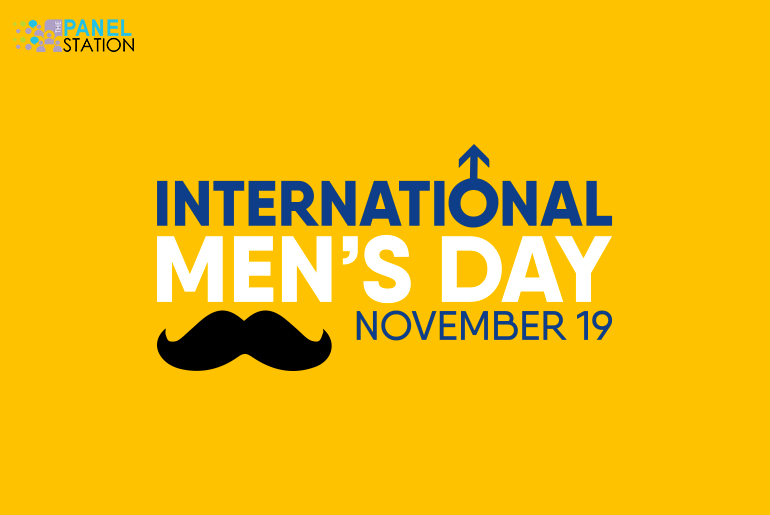Mental health conversations are everywhere. Social media posts remind us that “it’s okay not to be okay,” workplaces host mental health awareness weeks, and celebrities openly discuss their therapy journeys. Yet despite all this talk, women over 40 face unique mental health challenges that often go unaddressed. Between managing career demands, family responsibilities, aging parents, and hormonal changes, midlife women are struggling with mental health prioritization in ways that the general wellness conversation rarely acknowledges.
The problem isn’t awareness anymore, it is the implementation. Women in their 40s and beyond are caught in a perfect storm of responsibilities, expectations, and biological changes that make mental health awareness feel both essential and impossible. We’ve mastered the language of mental wellness, but we’re still learning how to live it during one of life’s most complex decades.
The Mental Health Challenges for Women Over 40
Mental health prioritization becomes particularly challenging for women over 40 due to a combination of factors that younger women and men simply don’t face in the same way. This is the decade when many women are simultaneously managing teenage children, aging parents, career peaks, and the onset of perimenopause or menopause.
Hormonal changes during perimenopause can begin as early as the late 30s and significantly impact mental health. Fluctuating estrogen levels can cause mood swings, anxiety, and depression, yet many women don’t realize these symptoms are connected to hormonal changes. This lack of awareness makes caring for mental health even more difficult because women may not understand what they’re experiencing.
The sandwich generation phenomenon particularly affects women over 40, who often find themselves caring for both children and aging parents. This dual caregiving responsibility can lead to caregiver burnout, chronic stress, and neglect of their own mental health needs. When you’re focused on everyone else’s wellbeing, paying attention to mental health for yourself often takes a backseat.
The Awareness vs. Action Gap in Midlife
Mental health has become a buzzword, but what does it actually mean for women navigating their 40s and beyond? It’s the difference between posting about self-care on Sunday and actually taking that mental health day when you’re overwhelmed by family obligations. It’s the gap between knowing you need support and feeling guilty about asking for it.
Women over 40 often face additional barriers to mental health prioritization. Many grew up in generations where mental health wasn’t discussed openly, making it harder to recognize when they need help. They may also feel that seeking mental health support is selfish when they have families depending on them.
Career pressures add another layer of complexity. Women in their 40s are often at crucial points in their careers, making it difficult to step back for mental health prioritization. The fear of being seen as unable to handle their responsibilities can prevent women from addressing mental health concerns before they become crises.
Why Mental Health Prioritization Feels Impossible After 40
Unlike earlier decades when you might have had more flexibility, your 40s often feel like a time when everyone needs you. Your children may be dealing with their own challenges, your parents might need increasing support, and your partner expects you to manage the household while also pursuing your career.
The physical changes that come with aging also impact mental health. Sleep disruption from hormonal changes, chronic pain from years of physical stress, and the reality of aging can all contribute to mental health challenges.
There’s also the unique stress of feeling like time is running out. Women over 40 often experience pressure to achieve certain life goals, make major career moves, or address relationship issues before it’s “too late.” This time pressure can make mental health prioritization feel like a luxury rather than a necessity.
The ripple effects extend to families as well. When women over 40 neglect their mental health, it affects their ability to support their children, care for aging parents, and maintain healthy relationships. The “strong woman” who never takes care of herself eventually becomes less able to care for others.
Signs You’re Not Prioritizing Mental Health Enough
Mental health prioritization isn’t just about crisis management—it’s about daily habits and choices. Women over 40 might not be prioritizing their mental health enough if they consistently sacrifice sleep to manage family responsibilities, ignore stress signals from their body, or feel guilty when they take time for themselves.
Other warning signs include always putting family needs before your own, avoiding difficult conversations that might reduce stress, or treating mental health care as a luxury rather than a necessity. If you find yourself saying “I’ll deal with this after the kids are older” or “I’ll focus on myself once my parents don’t need as much help,” you’re probably not engaging in adequate mental health support.
The tendency to normalize constant overwhelm is another red flag. When you start thinking that feeling exhausted, anxious, or depleted is just “how life is for women our age,” you’ve stopped prioritizing your mental wellbeing.
What Real Mental Health Prioritization Looks Like
True mental health prioritization goes beyond bubble baths and motivational quotes. For women over 40, it means making concrete changes to protect and nurture your mental wellbeing, even when family members or work demands seem more urgent.
Taking care of your mental health might look like setting boundaries with adult children who expect you to solve their problems, or having honest conversations with your partner about dividing household responsibilities more equitably. It could mean investing in therapy to process midlife transitions, or joining a support group for women navigating similar challenges.
Real mental health prioritization also means recognizing that mental health care is healthcare. Just as you wouldn’t skip a mammogram or annual physical, you shouldn’t postpone addressing mental health concerns because they seem less urgent than family needs.
Practical Steps for Better Mental Health Prioritization
Mental health prioritization doesn’t have to be overwhelming. Start by identifying one or two areas where you can make meaningful changes. This might be establishing better sleep hygiene, setting aside time for activities you enjoy, or learning to recognize your stress signals.
Regular check-ins with yourself are crucial for effective mental health prioritization. This could be as simple as asking yourself “How am I really feeling?” and being honest about the answer. If you notice persistent symptoms like anxiety, sadness, or irritability, don’t ignore them or attribute them solely to “just being busy.”
Building a support network is another essential aspect of mental health prioritization for women. This includes friends who understand your unique challenges, but it might also include professional support like therapists who specialize in midlife women’s issues.
Consider mental health prioritization as preventive care. Just as you might get regular health screenings to prevent physical problems, engaging in mental health practices before you’re in crisis can prevent more serious issues down the road.
The Role of Relationships in Mental Health Prioritization
Relationships often become more complex for women over 40, requiring intentional mental health prioritization to navigate successfully. This might include setting boundaries with adult children, renegotiating roles with partners, or dealing with the loss of aging parents.
Marital relationships often require extra attention during this life stage. The stress of midlife, combined with hormonal changes and family pressures, can strain even strong relationships. Mental health prioritization might include couples therapy or individual therapy to address relationship concerns.
Friendships may also change as women over 40 navigate different life circumstances. Some friends may not understand your mental health prioritization efforts, while others may be going through similar challenges. Building relationships with people who support your mental health goals is crucial.
Making Mental Health Prioritization Sustainable for Midlife Women
The goal isn’t perfection—it’s consistency. Effective mental health prioritization is about creating sustainable practices that you can maintain despite family obligations and work demands. This means being realistic about your capacity and building flexibility into your mental health routine.
Remember that mental health prioritization will look different for every woman over 40. What works for your friend or sister might not work for you, and that’s okay. The key is finding approaches that fit your lifestyle, family situation, and specific mental health needs.
It’s also important to recognize that mental health prioritization is an ongoing process, not a destination. Your mental health needs will change as you move through different life stages, and your approach to mental health prioritization should evolve accordingly.
Moving Forward: From Awareness to Action
The conversation about mental health has come a long way, but women over 40 need to shift from awareness to action. This means moving beyond knowing that mental health matters to actually making mental health prioritization a non-negotiable part of your life, even when family and work demands seem more urgent.
This shift requires both individual commitment and support from family members and healthcare providers. While you can’t control every aspect of your environment, you can control how you respond to stress, how you treat yourself, and what mental health prioritization practices you implement in your daily life.
Taking the First Step
If you’re a woman over 40 reading this and realizing that you need to improve your mental health, start small. Choose one area where you can make a meaningful change, whether that’s improving your sleep, seeking professional support, or simply being more honest about your mental health needs with your family.
Remember that mental health is essential. Taking care of your mental health isn’t just good for you; it’s good for everyone who depends on you. When you prioritize your mental wellbeing, you’re better equipped to show up as your best self for your family, your work, and your community.
The gap between saying “mental health matters” and actually living it can be bridged, but it requires intentional effort and commitment. Your mental health is worth prioritizing every single day, especially during the complex and demanding years of midlife and beyond.
FAQs on Importance of Mental Health
- How can I advocate for better mental health benefits at my workplace?
Initiate discussions with your manager or HR. Suggesting sensible changes such as flexible schedules, mental health days, and counseling services with confidentiality will bear good fruit.
- What are some warning signs that my “self-care” activities are actually avoidance behaviors?
If you find yourself binge-watching a ton of shows or scrolling for hours on social media to avoid confronting an emotion or problem, chances are you are avoiding versus practicing good self-care.
- How frequently should I reassess my mental wellness practices?
You should check in with yourself at least once a month. Ask yourself if your behaviors are contributing to your sense of balance or not and make changes when necessary.
- Are there cultural differences in how mental health prioritization is expressed?
Yes. Some cultures uphold community and family as the first line of support, while others emphasize therapy, clinical treatment, and individual care. Both approaches have valuable lessons.
- What role should technology companies play in protecting users’ mental health?
Tech companies should build in features that nudge healthy use, such as screen-time reminders and digital well-being tools, while employing less addictive design patterns.










